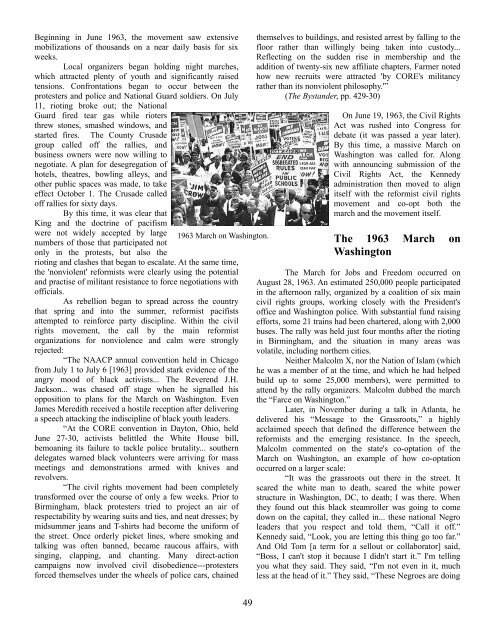smash-pacifism-zine
smash-pacifism-zine
smash-pacifism-zine
Create successful ePaper yourself
Turn your PDF publications into a flip-book with our unique Google optimized e-Paper software.
Beginning in June 1963, the movement saw extensive<br />
mobilizations of thousands on a near daily basis for six<br />
weeks.<br />
Local organizers began holding night marches,<br />
which attracted plenty of youth and significantly raised<br />
tensions. Confrontations began to occur between the<br />
protesters and police and National Guard soldiers. On July<br />
11, rioting broke out; the National<br />
Guard fired tear gas while rioters<br />
threw stones, <strong>smash</strong>ed windows, and<br />
started fires. The County Crusade<br />
group called off the rallies, and<br />
business owners were now willing to<br />
negotiate. A plan for desegregation of<br />
hotels, theatres, bowling alleys, and<br />
other public spaces was made, to take<br />
effect October 1. The Crusade called<br />
off rallies for sixty days.<br />
By this time, it was clear that<br />
King and the doctrine of <strong>pacifism</strong><br />
were not widely accepted by large<br />
numbers of those that participated not<br />
only in the protests, but also the<br />
rioting and clashes that began to escalate. At the same time,<br />
the 'nonviolent' reformists were clearly using the potential<br />
and practise of militant resistance to force negotiations with<br />
officials.<br />
As rebellion began to spread across the country<br />
that spring and into the summer, reformist pacifists<br />
attempted to reinforce party discipline. Within the civil<br />
rights movement, the call by the main reformist<br />
organizations for nonviolence and calm were strongly<br />
rejected:<br />
“The NAACP annual convention held in Chicago<br />
from July 1 to July 6 [1963] provided stark evidence of the<br />
angry mood of black activists... The Reverend J.H.<br />
Jackson... was chased off stage when he signalled his<br />
opposition to plans for the March on Washington. Even<br />
James Meredith received a hostile reception after delivering<br />
a speech attacking the indiscipline of black youth leaders.<br />
“At the CORE convention in Dayton, Ohio, held<br />
June 27-30, activists belittled the White House bill,<br />
bemoaning its failure to tackle police brutality... southern<br />
delegates warned black volunteers were arriving for mass<br />
meetings and demonstrations armed with knives and<br />
revolvers.<br />
“The civil rights movement had been completely<br />
transformed over the course of only a few weeks. Prior to<br />
Birmingham, black protesters tried to project an air of<br />
respectability by wearing suits and ties, and neat dresses; by<br />
midsummer jeans and T-shirts had become the uniform of<br />
the street. Once orderly picket lines, where smoking and<br />
talking was often banned, became raucous affairs, with<br />
singing, clapping, and chanting. Many direct-action<br />
campaigns now involved civil disobedience---protesters<br />
forced themselves under the wheels of police cars, chained<br />
1963 March on Washington.<br />
themselves to buildings, and resisted arrest by falling to the<br />
floor rather than willingly being taken into custody...<br />
Reflecting on the sudden rise in membership and the<br />
addition of twenty-six new affiliate chapters, Farmer noted<br />
how new recruits were attracted 'by CORE's militancy<br />
rather than its nonviolent philosophy.'”<br />
(The Bystander, pp. 429-30)<br />
On June 19, 1963, the Civil Rights<br />
Act was rushed into Congress for<br />
debate (it was passed a year later).<br />
By this time, a massive March on<br />
Washington was called for. Along<br />
with announcing submission of the<br />
Civil Rights Act, the Kennedy<br />
administration then moved to align<br />
itself with the reformist civil rights<br />
movement and co-opt both the<br />
march and the movement itself.<br />
The 1963 March on<br />
Washington<br />
The March for Jobs and Freedom occurred on<br />
August 28, 1963. An estimated 250,000 people participated<br />
in the afternoon rally, organized by a coalition of six main<br />
civil rights groups, working closely with the President's<br />
office and Washington police. With substantial fund raising<br />
efforts, some 21 trains had been chartered, along with 2,000<br />
buses. The rally was held just four months after the rioting<br />
in Birmingham, and the situation in many areas was<br />
volatile, including northern cities.<br />
Neither Malcolm X, nor the Nation of Islam (which<br />
he was a member of at the time, and which he had helped<br />
build up to some 25,000 members), were permitted to<br />
attend by the rally organizers. Malcolm dubbed the march<br />
the “Farce on Washington.”<br />
Later, in November during a talk in Atlanta, he<br />
delivered his “Message to the Grassroots,” a highly<br />
acclaimed speech that defined the difference between the<br />
reformists and the emerging resistance. In the speech,<br />
Malcolm commented on the state's co-optation of the<br />
March on Washington, an example of how co-optation<br />
occurred on a larger scale:<br />
“It was the grassroots out there in the street. It<br />
scared the white man to death, scared the white power<br />
structure in Washington, DC, to death; I was there. When<br />
they found out this black steamroller was going to come<br />
down on the capital, they called in... these national Negro<br />
leaders that you respect and told them, “Call it off.”<br />
Kennedy said, “Look, you are letting this thing go too far.”<br />
And Old Tom [a term for a sellout or collaborator] said,<br />
“Boss, I can't stop it because I didn't start it.” I'm telling<br />
you what they said. They said, “I'm not even in it, much<br />
less at the head of it.” They said, “These Negroes are doing<br />
49



